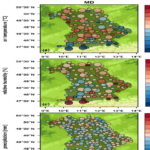HPC User Report from E. Collier and T. Mölg (Climate System Research Group)
A high-resolution present-day climatological atmospheric dataset for Bavaria
As part of recent efforts to investigate the impact of climate change on forest ecosystems in Bavaria, Germany, we developed a high-resolution atmospheric modelling dataset, BAYWRF, for this region covering the most recent climatological period. The dataset provides a unique and valuable tool for investigations of the climate dependence of economic, societal, ecological and agricultural processes in Bavaria.
Motivation and problem definition
Climate impact assessments require information about climate change at regional and ideally also local scales. In dendroecological studies, this information has traditionally been obtained using statistical methods, which preclude the linkage of local climate changes to large-scale drivers in a process-based way.
Methods and codes

To produce this dataset, we used the advanced research version of the Weather Research & Forecasting (WRF) model v. 4.2, which was configured with two nested domains of 7.5 and 1.5 km grid spacing centered over Bavaria and forced at the outer lateral boundaries by ERA5 reanalysis data between September 1987 and August 2018. WRF was developed by, and is maintained by, the National Centre for Atmospheric Research (NCAR), with bug fixes and enhancements contributed by the large community of users. The simulation period was divided into 31 annual simulations, each of which required 12 days of wall time with 320 processors on the Meggie compute cluster, for a total of 2.86 million core hours.
Results
Compared with an extensive network of observational data from the German Weather Service, the model represents variability in near-surface meteorological conditions generally well, including temporal and spatial variability in daily precipitation, although there are both seasonal and spatial biases in the dataset that interested users should consider
Outreach
This dataset is described in the following publication: Collier, E. and Mölg, T.: BAYWRF: a high-resolution present-day climatological atmospheric dataset for Bavaria, Earth Syst. Sci. Data, 12, 3097–3112, https://doi.org/10.5194/essd-12-3097-2020, 2020.
Data from the finest-resolution model domain are available for download at daily temporal resolution from a public repository at the Open Science Framework (Collier, 2020; https://doi.org/10.17605/OSF.IO/AQ58B).
Researcher’s Bio and Affiliation
Dr. Emily Collier recently completed a post-doctoral research position at FAU Erlangen-Nürnberg. Her research is focused on interactions between the atmosphere and the cryosphere. Her work has primarily involved using high-resolution models to investigate atmospheric influences on mountain glaciers around the world, considering spatial scales ranging from local conditions through to the large-scale circulation, and time periods spanning single weather events through to multi-decadal climatologies, as well as developing new coupled modelling tools.
